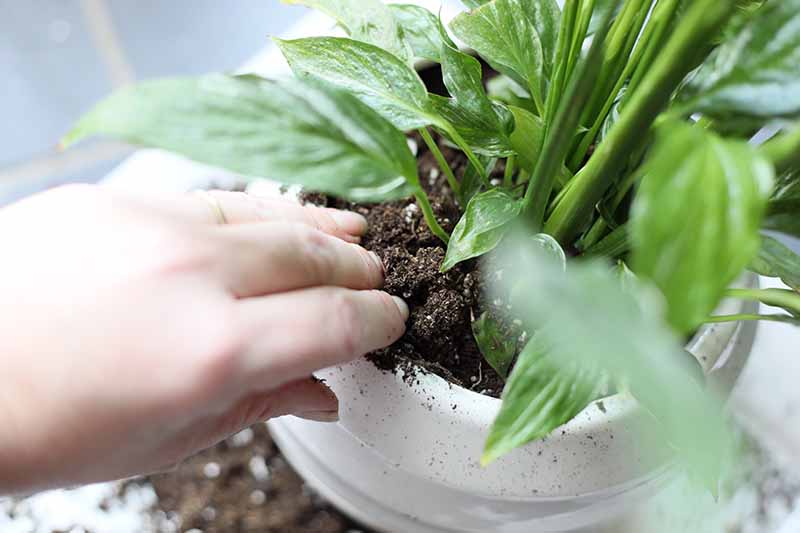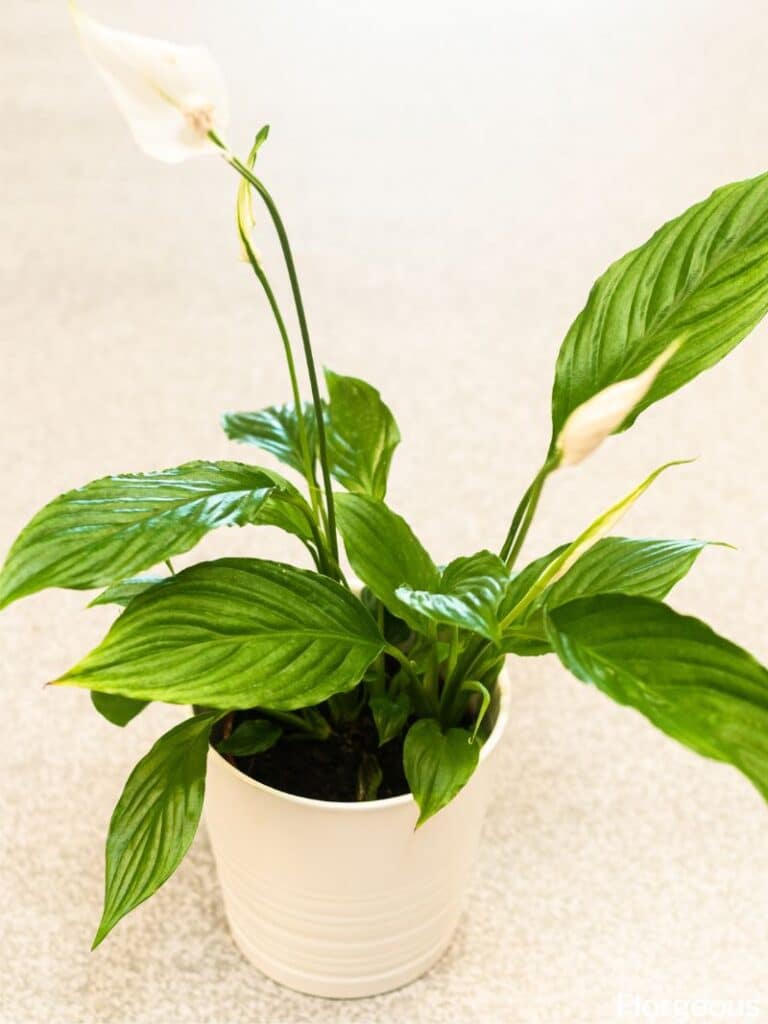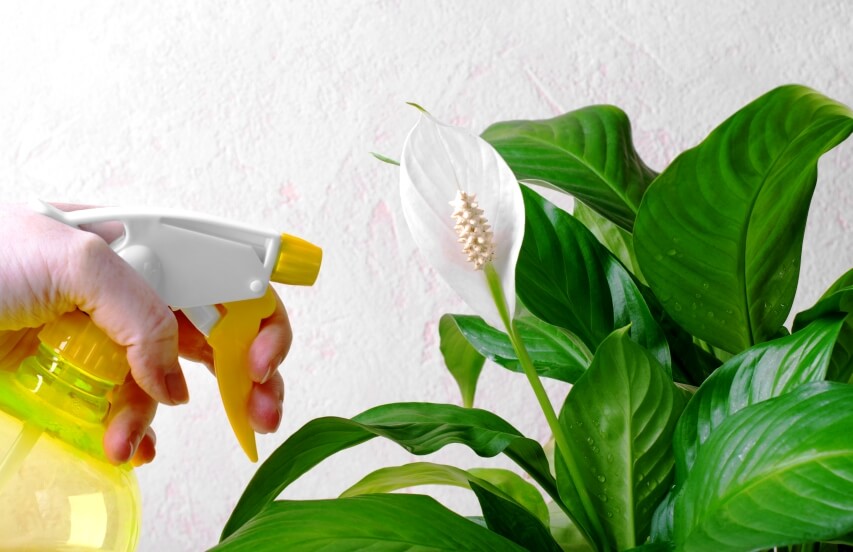Understanding the Unique Needs of Your Peace Lily
Peace lilies are known for their elegant white blooms and ability to purify the air, making them a popular choice for indoor gardens. However, these plants have specific requirements that must be met to ensure they thrive. One of the most critical factors is the type of potting soil used. Peace lilies prefer well-draining soil that is rich in organic matter, which allows for healthy root growth and development. Using a potting soil that is too dense or lacks proper drainage can lead to root rot and other problems.
In addition to well-draining soil, peace lilies also require moderate watering and high humidity. Overwatering can be detrimental to the plant, causing the roots to rot and the leaves to turn yellow. On the other hand, underwatering can cause the leaves to become dry and brittle. Maintaining a consistent level of moisture in the potting soil is crucial for the health and well-being of the plant.
The right potting soil for peace lilies can make a significant difference in their growth and health. A high-quality potting soil that is specifically designed for tropical plants like peace lilies can provide the necessary nutrients and support for healthy growth. Look for a potting soil that contains ingredients like peat moss, perlite, and vermiculite, which help to retain moisture, improve drainage, and support root growth.
By understanding the unique needs of your peace lily, you can provide the best possible care and create an environment that promotes healthy growth and development. Using a potting soil that is specifically designed for peace lilies is an essential part of this process, and can help to ensure that your plant thrives for years to come.
What to Look for in a Potting Soil for Peace Lilies
When selecting a potting soil for your peace lily, there are several key characteristics to look for. Good drainage is essential, as peace lilies are prone to root rot if the soil is too wet. Look for a potting soil that contains ingredients like perlite, vermiculite, or sand, which help to improve drainage and prevent waterlogging.
Aeration is also crucial, as peace lilies need oxygen to grow and thrive. A well-aerated potting soil will contain ingredients like peat moss or coconut coir, which help to improve soil structure and allow for healthy root growth.
Water-holding capacity is another important factor to consider. Peace lilies prefer soil that is consistently moist, but not waterlogged. A potting soil with good water-holding capacity will help to retain moisture, reducing the need for frequent watering.
pH levels are also important, as peace lilies prefer a slightly acidic to neutral soil pH (around 6.0-7.0). Look for a potting soil that is specifically formulated for tropical plants like peace lilies, as these soils tend to have a more acidic pH.
Nutrient content is also essential, as peace lilies require a balanced diet of nutrients to grow and thrive. Look for a potting soil that contains a balanced mix of nutrients, including nitrogen, phosphorus, and potassium.
By considering these key characteristics, you can select a high-quality potting soil that will provide your peace lily with the best possible growing conditions. Remember to always read the label and look for certifications like OMRI or USDA Organic, which ensure that the potting soil meets certain standards for quality and sustainability.
How to Choose the Best Potting Soil for Your Peace Lily
Choosing the right potting soil for your peace lily can be a daunting task, especially with the numerous options available in the market. However, by following a few simple tips, you can select a high-quality potting soil that meets the specific needs of your plant.
First, read the label carefully. Look for a potting soil that is specifically formulated for tropical plants like peace lilies. These soils tend to have a more acidic pH and contain ingredients that promote healthy root growth.
Next, check the ingredients. A good potting soil for peace lilies should contain a mix of peat moss, perlite, and vermiculite. These ingredients help to improve drainage, aeration, and water-holding capacity.
Consider certifications like OMRI or USDA Organic. These certifications ensure that the potting soil meets certain standards for quality and sustainability.
Another important factor to consider is the texture of the potting soil. Peace lilies prefer a well-draining soil that is not too dense or too dry. Avoid potting soils that contain a high amount of sand or silt, as these can cause the soil to become too dry.
Finally, read reviews and ask for recommendations from other peace lily enthusiasts. This can give you an idea of how well a particular potting soil performs in real-world conditions.
By following these tips, you can select a high-quality potting soil that meets the specific needs of your peace lily. Remember, the right potting soil can make a significant difference in the health and growth of your plant.
Top Picks for Potting Soil for Peace Lilies: A Review of Popular Brands
When it comes to choosing a potting soil for your peace lily, there are many options available. Here are some top picks from popular brands that are suitable for peace lilies:
Miracle-Gro Indoor Potting Mix is a popular choice among peace lily enthusiasts. This potting soil is specifically designed for indoor plants and contains a blend of peat moss, perlite, and vermiculite. It has good drainage and aeration, making it an ideal choice for peace lilies.
Black Kow All Purpose Potting Mix is another popular option. This potting soil is made from a blend of peat moss, perlite, and vermiculite, and is suitable for a wide range of plants, including peace lilies. It has good water-holding capacity and is resistant to compaction.
E.B. Stone Organics Indoor Plant Potting Mix is a high-quality, organic potting soil that is specifically designed for indoor plants. It contains a blend of peat moss, perlite, and vermiculite, and is rich in nutrients. This potting soil is an excellent choice for peace lilies, as it promotes healthy root growth and development.
Other popular brands that offer high-quality potting soil for peace lilies include Espoma Organic Indoor Potting Mix and Pro-Mix All Purpose Potting Mix. When choosing a potting soil, be sure to read the label and look for certifications like OMRI or USDA Organic.
It’s also important to note that while these potting soils are suitable for peace lilies, they may not be the best choice for every plant. Be sure to research the specific needs of your plant and choose a potting soil that meets those needs.
The Benefits of Using a High-Quality Potting Soil for Your Peace Lily
Using a high-quality potting soil for your peace lily can have a significant impact on its growth and health. A premium potting soil can provide improved drainage, increased nutrient uptake, and reduced risk of root rot and other diseases.
One of the main benefits of using a high-quality potting soil is improved drainage. Peace lilies prefer well-draining soil, and a potting soil that is too dense or waterlogged can lead to root rot and other problems. A high-quality potting soil will contain ingredients like perlite or vermiculite that help to improve drainage and prevent waterlogging.
Another benefit of using a high-quality potting soil is increased nutrient uptake. A premium potting soil will contain a balanced mix of nutrients that are specifically designed to meet the needs of peace lilies. This can help to promote healthy growth and development, and can even help to increase the plant’s resistance to disease.
Reduced risk of root rot and other diseases is another benefit of using a high-quality potting soil. A potting soil that is too dense or waterlogged can create an environment that is conducive to the growth of diseases. A high-quality potting soil will contain ingredients that help to prevent the growth of diseases, and can even help to promote the growth of beneficial microorganisms.
Overall, using a high-quality potting soil for your peace lily can have a significant impact on its growth and health. By providing improved drainage, increased nutrient uptake, and reduced risk of root rot and other diseases, a premium potting soil can help to promote healthy growth and development, and can even help to increase the plant’s resistance to disease.
Common Mistakes to Avoid When Using Potting Soil for Peace Lilies
When using potting soil for peace lilies, there are several common mistakes to avoid. One of the most common mistakes is overwatering. Peace lilies prefer well-draining soil, and too much water can lead to root rot and other problems.
Another common mistake is underwatering. While peace lilies prefer well-draining soil, they still need consistent moisture to thrive. Underwatering can cause the leaves to become dry and brittle, and can even lead to root damage.
Using soil that is too dense or too dry is also a common mistake. Peace lilies prefer a potting soil that is well-draining and has a good balance of moisture and aeration. Soil that is too dense or too dry can cause the roots to become waterlogged or dry out, leading to root damage and other problems.
Not repotting your peace lily often enough is another common mistake. Peace lilies typically need to be repotted every 1-2 years, as their roots can become pot-bound and need more room to grow. Not repotting your peace lily can cause the roots to become constricted, leading to reduced growth and health problems.
Finally, not using a high-quality potting soil is a common mistake. Peace lilies require a potting soil that is specifically designed for tropical plants, and that contains the right balance of nutrients and moisture. Using a low-quality potting soil can lead to reduced growth and health problems.
By avoiding these common mistakes, you can help ensure that your peace lily thrives and remains healthy. Remember to always use a high-quality potting soil, and to repot your peace lily regularly to give the roots room to grow.
DIY Potting Soil for Peace Lilies: A Recipe for a Custom Mix
Creating your own potting soil mix for peace lilies can be a fun and rewarding experience. By using a combination of ingredients like peat moss, perlite, and worm castings, you can create a custom mix that meets the specific needs of your plant.
Here is a recipe for a DIY potting soil mix for peace lilies:
Ingredients:
- 2 parts peat moss
- 1 part perlite
- 1 part worm castings
- 1/2 part vermiculite
- 1/2 part compost
Instructions:
1. Mix the peat moss, perlite, and worm castings together in a large bowl.
2. Add the vermiculite and compost to the mixture and stir until well combined.
3. Squeeze a handful of the mixture to test its moisture-holding capacity. If it holds its shape but crumbles easily, it’s ready to use. If it’s too dry, add a little more peat moss. If it’s too wet, add a little more perlite.
Benefits of creating your own potting soil mix:
By creating your own potting soil mix, you can ensure that your peace lily is getting the exact nutrients and moisture it needs to thrive. You can also customize the mix to meet the specific needs of your plant, whether it’s more acidic or more alkaline. Additionally, creating your own potting soil mix can be a cost-effective and sustainable option, as you can use ingredients that you may already have on hand.
Tips for Repotting Your Peace Lily with Fresh Potting Soil
Repotting your peace lily with fresh potting soil can be a great way to give your plant a boost of nutrients and help it thrive. Here are some tips to keep in mind when repotting your peace lily:
Choose the right time: Spring and summer are the best times to repot your peace lily, as the plant is actively growing during these seasons. Avoid repotting during the fall and winter months, as the plant is dormant and may not recover well from the stress of repotting.
Prepare the plant: Before repotting, make sure the plant is healthy and free of pests. Remove any dead or dying leaves, and trim back the roots if necessary.
Handle the roots with care: When repotting, handle the roots of the peace lily with care. Gently remove the plant from its pot, taking care not to damage the roots. If the roots are circling or growing out of the pot, gently tease them apart with your fingers or a blunt instrument.
Use fresh potting soil: Use a fresh, high-quality potting soil that is specifically designed for peace lilies. Avoid using potting soil that is old or of poor quality, as this can lead to nutrient deficiencies and other problems.
Water carefully: After repotting, water the plant carefully to settle the soil. Avoid overwatering, as this can lead to root rot and other problems.
Monitor the plant: After repotting, monitor the plant closely for any signs of stress or disease. Adjust the watering and fertilization schedule as needed to ensure the plant is thriving.







